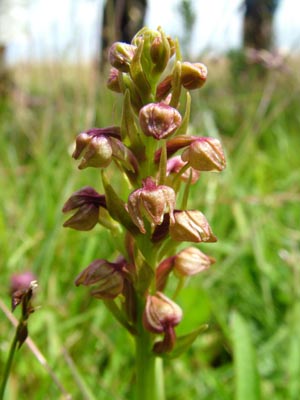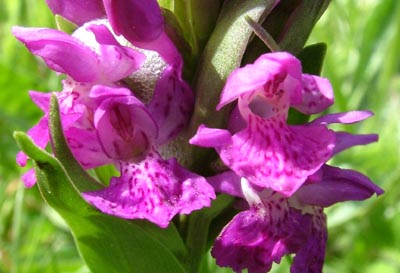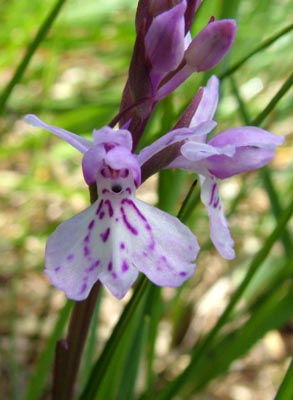We have three orchids on the local patch - Common Spotted Orchid - Dactylorhiza fuchsii, Heath Spotted Orchid - Dactylorhiza maculata and Northern Marsh Orchid - Dactylorhiza purpurella. I have taken many photographs of them this year, and find them very interesting and beautiful. So I decided to make a separate page for them. It should be noted that the views I express here are mine (although I have consulted specialists in coming to my conclusions) and since it is clear that these species are variable depending on location, these findings might well differ from yours.
There are a number of Dactylorhiza orchids. The precise number varies according to which book or which expert you consult, and they hybridise freely. In addition, species are being moved around the classifications as more genetic information is coming to light, so things haven't stabilised yet. An important example is the Frog Orchid, now Dactylorhiza viridis, but previously considered to be a Coeloglossum. In some references, the CSO was thought to be a subspecies of Heath Spotted Orchid. Since the Fragrant Orchid - Gymnadenia conopsea - also hybridises with CSO, I suspect another re-shuffle is on the way. This page, therefore, has to be seen as a local perspective at one point in time.
Although the Frog Orchid has only recently been moved into the Dactylorhiza, genetic studies show that it is actually more similar to the other Dactylorhiza than they are to each other. This suggests that Frog Orchid is possibly an ancestor of the modern Dactylorhiza. The following set of images, therefore, acts as a 'positioning overview' of the species being discussed on this page.

Frog Orchid
Common Spotted Orchid |
Heath Spotted Orchid |

Northern Marsh Orchid |
These are generally found on drier ground, such as path edges and verges. Characterised by a well-formed central lobe to the lower lip of the flower. Leaves may be spotted or not.
Usually found where there is lying water, either a bog or a stream or a ditch. Lower petal is 'frilled', rather than toothed. Again leaves spotted or not.
Always found near water, a uniform bright purple. Flower spikes not too long. Leaves usually spotted with dark blotches.
I've classified the following orchids as either Common Spotted Orchid x Heath Spotted Orchid, Common Spotted Orchid x Northern Marsh Orchid or Heath Spotted Orchid x Northern Marsh Orchid, since I know all three hybrids exist, and each specimen shown shows characteristics of more than one species. I'm aware that hybrids back-cross, so I expect to find all shades and ranges of variation that intergrade between the species.
Common Spotted Orchid x Heath Spotted Orchid
I'd call these specimens 'intermediates', rather than hybrids, because I have a sneaking suspicion that Common Spotted Orchid and Heath Spotted Orchid are actually the same species that varies according to habitat. I note that the hybrid chromosome counts are identical.
Common Spotted Orchid x Northern Marsh Orchid
I find a few orchids that show the characteristics of both Common Spotted Orchid and Northern Marsh Orchid. They tend to be very robust with many flowers in strong spikes and are, of course, intermediate in colour. Specimens with toothed lobes and which are a darker pink have been put in this category.
Heath Spotted Orchid x Northern Marsh Orchid
The habitats for Heath Spotted Orchid x Northern Marsh Orchid are very similar, so I find more of these. Again very robust, but generally lacking a large tooth to the lobe.
I thought it was worth making a record of our local orchids. This page shows a breath-taking variety of colour and form. I feel privileged to be able to show it to a wider audience than would normally be possible.































